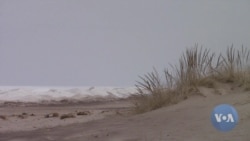More than 3.5 million people visit a sandy, hilly area called Indiana Dunes each year. It sits along the shores of Lake Michigan, about 80 kilometers southeast of Chicago, Illinois.
Visitors to the area swim and sail on the lake. They watch birds in the wetlands. They study plant life in the forests of oak and maple trees.
Now, the 6,000-hectare site is the newest national park in the United States. It became Indiana Dunes National Park in February.
Among the first to visit the new park were Bill and Betty Smith. They traveled from Connecticut to the state of Indiana, where the park is located. The two said they had already visited all 60 of the country’s other national parks.
Bill Smith said he was excited to see the sand dunes in person. He also wanted to explore some of the park’s 80 kilometers of hiking paths. “I just want to get a sense of the place,” he said of America’s 61st national park.
Strong winds from Lake Michigan -- one of America’s five so-called Great Lakes -- created the park’s sand dunes over time. Some dunes are still forming today. The winds create the dunes by dropping loose sand onto land. Some of the dunes here look partly round. Others take the form of long, narrow hills.
The smooth sands of the dunes and lakeshore make an almost musical sound when people walk on them. The sounds can sometimes be heard several meters away. Visitors like to say that the sand dunes “sing.”
A surprise name change
It has been a long, hard fight to get Indiana Dunes designated as a national park. The park’s superintendent, Paul Labovitz, said the process was “103 years in the making.”
The idea was first proposed in 1916 -- the same year the National Park Service was established. But World War I and the need for steel mills on the lakefront to support the war effort delayed such plans for the park. Later efforts to get the national park designation were halted by industrialization of the nearby Port of Indiana, the largest commercial port on Lake Michigan.
More recently, Indiana lawmakers presented the idea to Congress in 2017 and 2018. But no action was taken.
It took the longest-ever government shutdown in American history to bring about change for Indiana Dunes, says Lorelei Weimer. She is the park’s director of tourism. She said that one Indiana congressman was able to include the measure into the new legislation in January.
U.S. lawmakers were rushed to pass the funding bill in order to reopen the government.
Weimer said, “The fact that (the Indiana lawmaker) was able to get it into the budget bill was a huge win for us.”
The designation came as a surprise to Weimer and many others. She said, “None of us knew that was going to happen.”
The designation does not come with any new rules or big financial changes for Indiana Dunes. It does, however, give the area the same recognition as more well-known national parks like Yellowstone and Yosemite.
The U.S. National Park Service system includes more than 400 parks, monuments, historic sites and other protected areas. For many years, Indiana Dunes was a national lakeshore within the park system.
‘An international attraction’
Park Superintendent Labovitz called the park one of the most ecologically mixed places in North America. Indiana Dunes has about 1,500 different kinds of plants, he said.
The Dunes are also along a major migration path, and birdwatching is a big reason visitors come to Indiana Dunes each year. The area is home to more than 300 species of birds, including waterbirds such as loons and herons, as well as birds of prey like bald eagles and hawks. Several species of songbirds also live there.
Weimer said people from about 50 countries visit the park each year. The park offers guidebooks in 12 languages. “This is not just a local attraction,” Weimer said of the park. “It’s an international attraction.”
I'm Caty Weaver.
And I’m Ashley Thompson.
Erika Celeste reported this story for VOA News. Ashley Thompson adapted it for VOA Learning English, using earlier Learning English reports by Jerilyn Watson. Kelly Jean Kelly was the editor.
Tell us about a national park or natural area you have visited, either in your country or in the United States. Write to us in the comments section.
_____________________________________________________________
Words in This Story
hike - v. to walk a long distance especially for pleasure or exercise
designate - v. to officially choose (someone or something) to do or be something : to officially give (someone or something) a particular role or purpose
superintendent - n. a person who directs or manages a place, department, organization, etc.
commercial - adj. related to or used in the buying and selling of goods and services
tourism - n. the activity of traveling to a place for pleasure
ecology - n. a science that deals with the relationships between groups of living things and their environments









